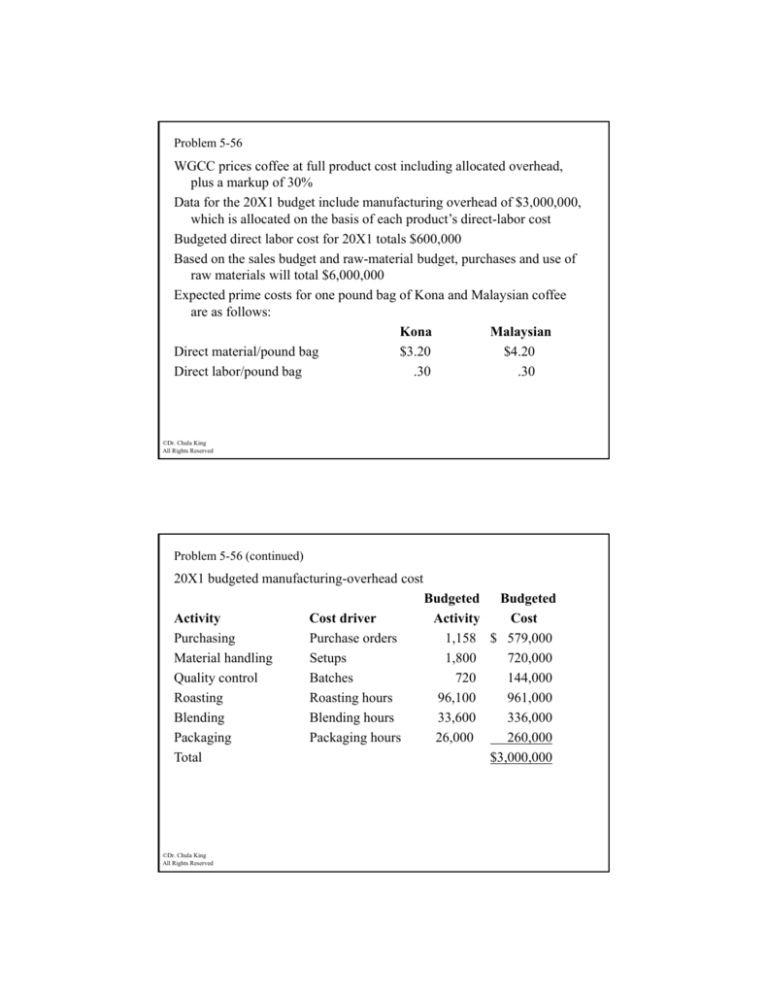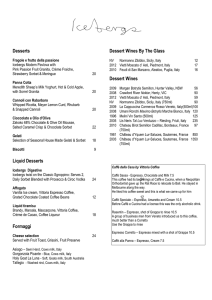
Problem 5-56
WGCC prices coffee at full product cost including allocated overhead,
plus a markup of 30%
Data for the 20X1 budget include manufacturing overhead of $3,000,000,
which is allocated on the basis of each product’s direct-labor cost
Budgeted
d
d direct
di
labor
l b cost for
f 20X1 totals
l $600,000
$
Based on the sales budget and raw-material budget, purchases and use of
raw materials will total $6,000,000
Expected prime costs for one pound bag of Kona and Malaysian coffee
are as follows:
Kona
Malaysian
Di
Direct
material/pound
i l/
d bag
b
$3 20
$3.20
$4 20
$4.20
Direct labor/pound bag
.30
.30
©Dr. Chula King
All Rights Reserved
Problem 5-56 (continued)
20X1 budgeted manufacturing-overhead cost
Activity
Purchasing
Material handling
Quality control
Roasting
Blending
Packaging
Total
©Dr. Chula King
All Rights Reserved
Cost driver
Purchase orders
Setups
Batches
Roasting hours
Blending hours
Packaging hours
Budgeted Budgeted
Activity
Cost
1,158 $ 579,000
1,800
720,000
720
144,000
96,100
961,000
33,600
336,000
26,000
260,000
$3 000 000
$3,000,000
Problem 5-56 (continued)
20X1 data for production of Kona and Malaysian coffee:
Kona
Malaysian
Budgeted sales
2,000 lb
100,000 lb
Batch size
500 lb
10,000 lb
Setups
3 per batch
3 per batch
Purchase order size
500 lb
25,000 lb
Roasting time
1 hr. per 100 lb
1 hr. per 100 lb
Blending time
0.5 hr. per 100 lb
0.5 hr. per 100 lb
Packaging time
0.1 hr. per 100 lb
0.1 hr. per 100 lb
©Dr. Chula King
All Rights Reserved
Problem 5-56 (continued)
Part 1(a): Using WGCC’s current product-costing system, determine the
company’s predetermined overhead rate using direct-labor cost as the
single cost driver.
$5 per direct labor dollar ($3,000,000 ÷ $600,000)
Part 1(b): Using
i WGCC’s current product-costing
d
i system, determine
d
i the
h
full product cost and selling prices of one pound of Kona coffee and
one pound of Malaysian coffee.
Kona
Malaysian
Direct material
$3.20
$4.20
Direct labor
.30
.30
O h d ((.30
Overhead
30 x $5)
1 50
1.50
1 50
1.50
Full product cost
$5.00
$6.00
30% markup
1.50
1.80
Selling price
$6.50
$7.80
©Dr. Chula King
All Rights Reserved
Problem 5-56 (continued)
Part 2: Develop a new product cost, using an activity-based costing
approach, for one pound of Kona coffee and one pound of Malaysian
coffee:
First, determine the unit cost for each of the activities (Cost ÷ Activity):
Budgeted
Budgeted
Unit
Activity
Cost driver
Activity
Cost
Cost
Purchasing
Purchase orders
1,158 $ 579,000
$500
Material handling Setups
1,800
720,000
400
Quality control
Batches
720
144,000
200
Roasting
Roasting hours
96,100
961,000
10
Blending
Blending hours 33,600
336,000
10
Packaging
Packaging hours 26,000
260,000
10
©Dr. Chula King
All Rights Reserved
Problem 5-56 (continued)
Standard Cost per pound: Kona Coffee (2,000 lbs)
Direct material (given)
$3.20
Direct labor (given)
.30
Purchasing (2,000 ÷ 500 = 4 orders x $500 = $2,000 ÷ 2,000)
1.00
Material handling (3x4 batches=12 setups x$400=$4,800÷2,000) 2.40
Quality control (4 batches x $200 = $800 ÷2,000)
.40
Roasting (20 hrs x $10 = $200 ÷ 2,000)
.10
Blending (10 hrs x $10 = $100 ÷ 2,000)
.05
Packaging (2 hrs x $10 = $20 ÷ 2,000)
.01
Total cost
$7 46
$7.46
©Dr. Chula King
All Rights Reserved
Problem 5-56 (continued)
Standard Cost per pound: Malaysian Coffee (100,000 lbs)
Direct material (given)
$4.20
Direct labor (given)
.30
Purchasing (100,000÷25,000=4 ordersx$500=$2,000÷100,000)
.02
Material handling (3x10batches=30setupsx$400=$12,000
÷100,000)
.12
Quality control (10 batches x $200 = $2,000 ÷100,000)
.02
Roasting (1,000 hrs x $10 = $10,000 ÷ 100,000)
.10
Blending (500 hrs x $10 = $5,000 ÷ 100,000)
.05
Packaging
g g (100
(
hrs x $10
$ = $1,000
$ ,
÷ 100,000)
,
)
.01
Total cost
$4.82
©Dr. Chula King
All Rights Reserved
Problem 5-56 (continued)
Part 3(a): What are the implications of the activity-based costing system
with respect to the use of direct labor as a basis for applying overhead
to products?
Under ABC, several activities other than direct labor drive overhead.
Because of this,
this the current system significantly undercosts the low
volume Kona coffee ($6.50 versus $7.46), and overcosts the high
volume Malaysian coffee ($7.80 versus $4.82).
Part 3(b): What are the implications of the activity-based costing system
with respect to the use of the existing product-costing system as the
basis of pricing.
g pprice of $$6.50 compared
p
to its
Kona,, the low volume pproduct has a selling
ABC cost of $7.46. Therefore, the selling price is not covering the cost
of the Kona. As a result the high volume, high margin Malaysian
coffee is subsidizing Kona coffee.
©Dr. Chula King
All Rights Reserved

